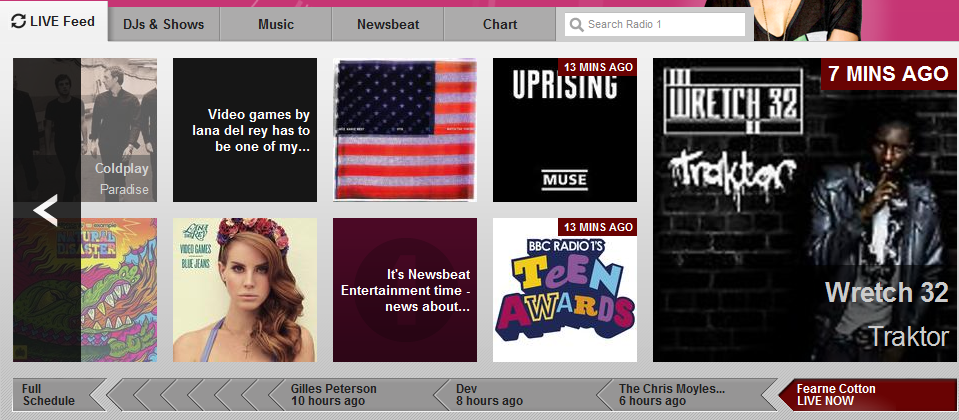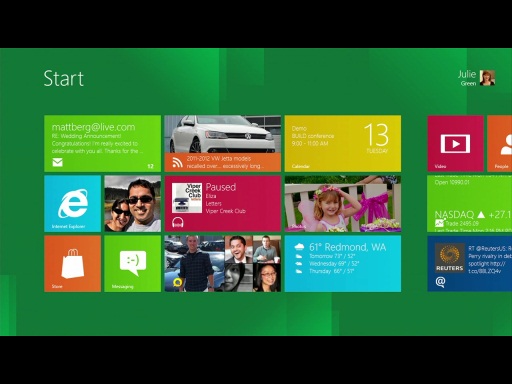Windows 8
I've been writing a comprehensive, all-encompassing review of Microsoft Windows 8 since the first day of the BUILD conference on September 13th, but it has become too big of a task. So I've binned that and changed my strategy. If I were to sum up Windows 8 in a nutshell, it would go something like this:
Everything is the same as Windows 7, except you have a new Start menu using a technology called "Metro" that takes up the entire screen.
Metro
Metro is the new user interface for colourful, connected, clean, touchable applications. It is "touch first", so it is designed to work brilliantly well when your device responds to your greasy digits being dragged across it; but they say it works equally well with a keyboard and mouse.
That's rubbish. It is LESS good with a keyboard and mouse.
But that's not to say it is a bad experience. In fact, it works very well and the animations are still fluid. The nasty feature of horizontal scroll is easily operated by the scroll wheel on your mouse. Having BIG tiles to click on instead of icons feels nicer too, it's easier to work with and allows you to be really sloppy with you mouse control.
The best thing about Metro is the sheer genius of making the tiles "active". Your weather icon now shows real-time information about weather YOU care about. That's clever stuff!! It is also remarkably UNlike the homescreen widgets you get on Android. No patent lawsuits here!
Microsoft's Native Web
Microsoft said a very odd thing when they launched Internet Explorer 10. They said "the future is the native web".
This is as anti-Web as it gets. The web shouldn't rely on your browser choice, it should be browser-agnostic, but still kudos to them for making the effort to allow hardware acceleration of JavaScript and HTML5 things in their IE10 browser. But it only works in an open and webby way if they make it easy for other browsers to do the same level of acceleration as Microsoft can, without knowing the ins and outs of the underlying operating system as well as the Bill Gates Steve Ballmer crew obviously do.
This move is Microsoft trying to regain their browser market share and to promote web use (which is all anybody does nowadays - you're doing it right now!!) on Windows. They're allowed to do that because they're a business and market share is an important measurement.
Microsoft's Real Achievement
But I have a hunch that the real market-share success is one that won't actually earn them any money: they have just spawned a Metro-style web.
Metro works exceedingly well for touch devices (phones, tablets, touch-screen monitors, etc) and quite well for non-touch-screen devices. Metro could be the key to a standardised and aesthetically pleasing Internet that allows for natural interactivity concepts (such as swipe and pinch).
Am I mad for thinking anybody would actually want to standardise to Metro? Well, I am only basing my theory on a little known pokey media company called the BBC.
The BBC is going to be rolling out a new website soon and it looks remarkably like Metro. And yet, the only comment I've heard about it is "It looks nice, a but busy, but it doesn't support touch!!".
The BBC Radio 1 homepage also includes some Metro-esque features (although again is let down by a lack of touch support).

Touch is so important now to successful websites (admittedly, this site only supports what your browser gives you for free, but there are things in development to make it much more finger-friendly!) and everybody settling on a fairly common standard of design is A Good Thing. Sure, if you're a design house, you want to break all the conventions and show off your creative madskills; but if you're a high-volume website and you don't want users to be reluctant because they have to work out your menus and layouts before actually getting to your content then Metro-style seems the obvious way to do that.
It will become even more obvious if Microsoft can move the 400 million Windows 7 users to Windows 8 because very few platforms offer such consumer penetration (steady!!) and to keep your users in their comfort zone is imperative to keeping them engaged and, in many cases, shopping.

Comments...